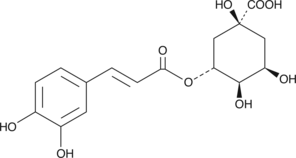Chemicals
Showing 14401–14550 of 41137 results
-
Chlorhexidine (CHX) is an antimicrobial agent often used in antiseptics and dental products such as toothpaste and mouthwash. CHX completely inhibits matrix metalloproteinases (MMP) -2 and -9 at concentrations of 0.0001% and 0.002%, respectively, in a gelatin degradation assay.{28418} Inhibition of collagen degradation by MMP-8 is completely inhibited by CHX at a concentration of 0.01%. Addition of calcium to the MMP assays prevented inhibition, suggesting that CHX may act via a cation-chelating mechanism.{28418}
Brand:CaymanSKU:-Available on backorder
Chlorhexidine (CHX) is an antimicrobial agent often used in antiseptics and dental products such as toothpaste and mouthwash. CHX completely inhibits matrix metalloproteinases (MMP) -2 and -9 at concentrations of 0.0001% and 0.002%, respectively, in a gelatin degradation assay.{28418} Inhibition of collagen degradation by MMP-8 is completely inhibited by CHX at a concentration of 0.01%. Addition of calcium to the MMP assays prevented inhibition, suggesting that CHX may act via a cation-chelating mechanism.{28418}
Brand:CaymanSKU:-Available on backorder
Chlorido[N,N’-disalicylidene-1,2-phenylenediamine]iron(III) is an inducer of ferroptosis.{50243} It induces ferroptosis, but not apoptosis or necroptosis, in NB1 cancer cells when used at a concentration of 3 µM.{50243} Chlorido[N,N’-disalicylidene-1,2-phenylenediamine]iron(III) inhibits proliferation of BJAB, NALM-6, Jurkat, MelHO, and MCF-7 cancer cells (IC50s = 0.07, 2.5, 1.5, 3, and 5 µM, respectively), as well as NALM-6 cells resistant to daunorubicin (Item No. 14159) and vincristine (Item No. 11764) when used at concentrations ranging from 0.04 to 0.125 µM.{45533}
Brand:CaymanSKU:28788 - 10 mgAvailable on backorder
Chlorido[N,N’-disalicylidene-1,2-phenylenediamine]iron(III) is an inducer of ferroptosis.{50243} It induces ferroptosis, but not apoptosis or necroptosis, in NB1 cancer cells when used at a concentration of 3 µM.{50243} Chlorido[N,N’-disalicylidene-1,2-phenylenediamine]iron(III) inhibits proliferation of BJAB, NALM-6, Jurkat, MelHO, and MCF-7 cancer cells (IC50s = 0.07, 2.5, 1.5, 3, and 5 µM, respectively), as well as NALM-6 cells resistant to daunorubicin (Item No. 14159) and vincristine (Item No. 11764) when used at concentrations ranging from 0.04 to 0.125 µM.{45533}
Brand:CaymanSKU:28788 - 100 mgAvailable on backorder
Chlorido[N,N’-disalicylidene-1,2-phenylenediamine]iron(III) is an inducer of ferroptosis.{50243} It induces ferroptosis, but not apoptosis or necroptosis, in NB1 cancer cells when used at a concentration of 3 µM.{50243} Chlorido[N,N’-disalicylidene-1,2-phenylenediamine]iron(III) inhibits proliferation of BJAB, NALM-6, Jurkat, MelHO, and MCF-7 cancer cells (IC50s = 0.07, 2.5, 1.5, 3, and 5 µM, respectively), as well as NALM-6 cells resistant to daunorubicin (Item No. 14159) and vincristine (Item No. 11764) when used at concentrations ranging from 0.04 to 0.125 µM.{45533}
Brand:CaymanSKU:28788 - 5 mgAvailable on backorder
Chlorido[N,N’-disalicylidene-1,2-phenylenediamine]iron(III) is an inducer of ferroptosis.{50243} It induces ferroptosis, but not apoptosis or necroptosis, in NB1 cancer cells when used at a concentration of 3 µM.{50243} Chlorido[N,N’-disalicylidene-1,2-phenylenediamine]iron(III) inhibits proliferation of BJAB, NALM-6, Jurkat, MelHO, and MCF-7 cancer cells (IC50s = 0.07, 2.5, 1.5, 3, and 5 µM, respectively), as well as NALM-6 cells resistant to daunorubicin (Item No. 14159) and vincristine (Item No. 11764) when used at concentrations ranging from 0.04 to 0.125 µM.{45533}
Brand:CaymanSKU:28788 - 50 mgAvailable on backorder
Chlorin e6 (Ce6) is a second-generation photosensitizer with antitumor activity when used in conjunction with irradiation. In a mouse model of implanted fibrosarcoma, Ce6 (2.5-10 mg/kg, i.v. with irradiation at 50-200 J/cm2) led to complete tumor loss following varying levels of irradiation.{33795} A formulation including Ce6 was tested in a Phase I clinical study for patients with bronchogenic early superficial squamous cell carcinoma with positive results (40 mg/m2, i.v. with laser irradiation at 100 J/cm2).{33832} The same dosing paradigm in a Phase II clinical trial for early stage lung cancer patients led to a complete response in 82.9% of patients.{33794} Ce6 has been examined as a nanotechnology drug delivery tool.{33793}
Brand:CaymanSKU:21684 -Out of stock
Chlorin e6 (Ce6) is a second-generation photosensitizer with antitumor activity when used in conjunction with irradiation. In a mouse model of implanted fibrosarcoma, Ce6 (2.5-10 mg/kg, i.v. with irradiation at 50-200 J/cm2) led to complete tumor loss following varying levels of irradiation.{33795} A formulation including Ce6 was tested in a Phase I clinical study for patients with bronchogenic early superficial squamous cell carcinoma with positive results (40 mg/m2, i.v. with laser irradiation at 100 J/cm2).{33832} The same dosing paradigm in a Phase II clinical trial for early stage lung cancer patients led to a complete response in 82.9% of patients.{33794} Ce6 has been examined as a nanotechnology drug delivery tool.{33793}
Brand:CaymanSKU:21684 -Out of stock
Chlorin e6 (Ce6) is a second-generation photosensitizer with antitumor activity when used in conjunction with irradiation. In a mouse model of implanted fibrosarcoma, Ce6 (2.5-10 mg/kg, i.v. with irradiation at 50-200 J/cm2) led to complete tumor loss following varying levels of irradiation.{33795} A formulation including Ce6 was tested in a Phase I clinical study for patients with bronchogenic early superficial squamous cell carcinoma with positive results (40 mg/m2, i.v. with laser irradiation at 100 J/cm2).{33832} The same dosing paradigm in a Phase II clinical trial for early stage lung cancer patients led to a complete response in 82.9% of patients.{33794} Ce6 has been examined as a nanotechnology drug delivery tool.{33793}
Brand:CaymanSKU:21684 -Out of stock
Chlorin e6 (Ce6) is a second-generation photosensitizer with antitumor activity when used in conjunction with irradiation. In a mouse model of implanted fibrosarcoma, Ce6 (2.5-10 mg/kg, i.v. with irradiation at 50-200 J/cm2) led to complete tumor loss following varying levels of irradiation.{33795} A formulation including Ce6 was tested in a Phase I clinical study for patients with bronchogenic early superficial squamous cell carcinoma with positive results (40 mg/m2, i.v. with laser irradiation at 100 J/cm2).{33832} The same dosing paradigm in a Phase II clinical trial for early stage lung cancer patients led to a complete response in 82.9% of patients.{33794} Ce6 has been examined as a nanotechnology drug delivery tool.{33793}
Brand:CaymanSKU:21684 -Out of stock
Chlorisondamine is an antagonist of nicotinic acetylcholine receptors (nAChRs; IC50 = 1.8 µM in rat striatal synaptosomes) and a ganglion blocker.{38466} It decreases dopamine release induced by nicotine (Item Nos. 16535 | 20887) in a dose-dependent manner in rat striatal synaptosomes at concentrations ranging from 0-100 µM. The effect of chlorisondamine is long-lasting, with a 10 mg/kg dose blocking nicotine-induced stimulant activity for at least five weeks.{38463} Chlorisondamine (5 µg, i.c.v.) prevents rats from acquiring a (–)-nicotine-induced conditioned taste aversion response, a model of the aversive effects of nicotine.{38465} It also inhibits autonomic ganglia, providing approximately 50% inhibition of the contractile response in feline superior cervical ganglion nictitating membrane preparations when administered at a dose of 50 mg/kg.{38464}
Brand:CaymanSKU:20119 -Available on backorder
Chlorisondamine is an antagonist of nicotinic acetylcholine receptors (nAChRs; IC50 = 1.8 µM in rat striatal synaptosomes) and a ganglion blocker.{38466} It decreases dopamine release induced by nicotine (Item Nos. 16535 | 20887) in a dose-dependent manner in rat striatal synaptosomes at concentrations ranging from 0-100 µM. The effect of chlorisondamine is long-lasting, with a 10 mg/kg dose blocking nicotine-induced stimulant activity for at least five weeks.{38463} Chlorisondamine (5 µg, i.c.v.) prevents rats from acquiring a (–)-nicotine-induced conditioned taste aversion response, a model of the aversive effects of nicotine.{38465} It also inhibits autonomic ganglia, providing approximately 50% inhibition of the contractile response in feline superior cervical ganglion nictitating membrane preparations when administered at a dose of 50 mg/kg.{38464}
Brand:CaymanSKU:20119 -Available on backorder
Chlorisondamine is an antagonist of nicotinic acetylcholine receptors (nAChRs; IC50 = 1.8 µM in rat striatal synaptosomes) and a ganglion blocker.{38466} It decreases dopamine release induced by nicotine (Item Nos. 16535 | 20887) in a dose-dependent manner in rat striatal synaptosomes at concentrations ranging from 0-100 µM. The effect of chlorisondamine is long-lasting, with a 10 mg/kg dose blocking nicotine-induced stimulant activity for at least five weeks.{38463} Chlorisondamine (5 µg, i.c.v.) prevents rats from acquiring a (–)-nicotine-induced conditioned taste aversion response, a model of the aversive effects of nicotine.{38465} It also inhibits autonomic ganglia, providing approximately 50% inhibition of the contractile response in feline superior cervical ganglion nictitating membrane preparations when administered at a dose of 50 mg/kg.{38464}
Brand:CaymanSKU:20119 -Available on backorder
Chlorisondamine is an antagonist of nicotinic acetylcholine receptors (nAChRs; IC50 = 1.8 µM in rat striatal synaptosomes) and a ganglion blocker.{38466} It decreases dopamine release induced by nicotine (Item Nos. 16535 | 20887) in a dose-dependent manner in rat striatal synaptosomes at concentrations ranging from 0-100 µM. The effect of chlorisondamine is long-lasting, with a 10 mg/kg dose blocking nicotine-induced stimulant activity for at least five weeks.{38463} Chlorisondamine (5 µg, i.c.v.) prevents rats from acquiring a (–)-nicotine-induced conditioned taste aversion response, a model of the aversive effects of nicotine.{38465} It also inhibits autonomic ganglia, providing approximately 50% inhibition of the contractile response in feline superior cervical ganglion nictitating membrane preparations when administered at a dose of 50 mg/kg.{38464}
Brand:CaymanSKU:20119 -Available on backorder
Chlormadinone acetate is a synthetic progestin.{45702} It binds to progesterone, androgen, and glucocorticoid receptors in vitro (Kis = 2.5, 3.8, and 16 nM, respectively, for the human receptors). Chlormadinone acetate increases the number of endometrial glands and uterine weight in β-estradiol-primed rabbits when administered at a dose of 45 µg/kg per day for five days. Chlormadinone acetate reduces testosterone-induced increases in the seminal vesicle weight of castrated male rats when administered at doses of 4.6 and 21.5 mg/kg per day for eight days.
Brand:CaymanSKU:29392 - 1 gAvailable on backorder
Chlormadinone acetate is a synthetic progestin.{45702} It binds to progesterone, androgen, and glucocorticoid receptors in vitro (Kis = 2.5, 3.8, and 16 nM, respectively, for the human receptors). Chlormadinone acetate increases the number of endometrial glands and uterine weight in β-estradiol-primed rabbits when administered at a dose of 45 µg/kg per day for five days. Chlormadinone acetate reduces testosterone-induced increases in the seminal vesicle weight of castrated male rats when administered at doses of 4.6 and 21.5 mg/kg per day for eight days.
Brand:CaymanSKU:29392 - 250 mgAvailable on backorder
Chlormadinone acetate is a synthetic progestin.{45702} It binds to progesterone, androgen, and glucocorticoid receptors in vitro (Kis = 2.5, 3.8, and 16 nM, respectively, for the human receptors). Chlormadinone acetate increases the number of endometrial glands and uterine weight in β-estradiol-primed rabbits when administered at a dose of 45 µg/kg per day for five days. Chlormadinone acetate reduces testosterone-induced increases in the seminal vesicle weight of castrated male rats when administered at doses of 4.6 and 21.5 mg/kg per day for eight days.
Brand:CaymanSKU:29392 - 500 mgAvailable on backorder
Chlormezanone is a centrally acting muscle relaxant.{43296} It induces paralysis in mice, guinea pigs, dogs, cats, and monkeys (EC50s = 133, <200, 100-250, 50, and 50 mg/kg, respectively). Chlormezanone increases ataxia induced by pentobarbital and alcohol in mice and blocks the crossed extensor reflex of the spine without affecting the knee-jerk reflex in cats. It also induces head drop in rabbits.
Brand:CaymanSKU:25716 - 1 gAvailable on backorder
Chlormezanone is a centrally acting muscle relaxant.{43296} It induces paralysis in mice, guinea pigs, dogs, cats, and monkeys (EC50s = 133, <200, 100-250, 50, and 50 mg/kg, respectively). Chlormezanone increases ataxia induced by pentobarbital and alcohol in mice and blocks the crossed extensor reflex of the spine without affecting the knee-jerk reflex in cats. It also induces head drop in rabbits.
Brand:CaymanSKU:25716 - 500 mgAvailable on backorder
Chlorogenic acid is a phenolic natural product isolated from the leaves and fruits of dicotyledonous plants, including the coffee bean. Structurally, chlorogenic acid is the ester of caffeic acid with the 3-hydroxyl group of quinic acid. Chlorogenic acid is an important factor in plant metabolism. It is also an antioxidant and an inhibitor of the tumor promoting activity of phorbol esters.{1430,1420} Chlorogenic acid, at concentrations as high as 100 µM, does not inhibit the 5-lipoxygenase activity of ionophore-stimulated human polymorphonuclear leukocytes.{4706}
Brand:CaymanSKU:70930 - 1 gAvailable on backorder
Chlorogenic acid is a phenolic natural product isolated from the leaves and fruits of dicotyledonous plants, including the coffee bean. Structurally, chlorogenic acid is the ester of caffeic acid with the 3-hydroxyl group of quinic acid. Chlorogenic acid is an important factor in plant metabolism. It is also an antioxidant and an inhibitor of the tumor promoting activity of phorbol esters.{1430,1420} Chlorogenic acid, at concentrations as high as 100 µM, does not inhibit the 5-lipoxygenase activity of ionophore-stimulated human polymorphonuclear leukocytes.{4706}
Brand:CaymanSKU:70930 - 100 mgAvailable on backorder
Chlorogenic acid is a phenolic natural product isolated from the leaves and fruits of dicotyledonous plants, including the coffee bean. Structurally, chlorogenic acid is the ester of caffeic acid with the 3-hydroxyl group of quinic acid. Chlorogenic acid is an important factor in plant metabolism. It is also an antioxidant and an inhibitor of the tumor promoting activity of phorbol esters.{1430,1420} Chlorogenic acid, at concentrations as high as 100 µM, does not inhibit the 5-lipoxygenase activity of ionophore-stimulated human polymorphonuclear leukocytes.{4706}
Brand:CaymanSKU:70930 - 5 gAvailable on backorder
Chlorogenic acid is a phenolic natural product isolated from the leaves and fruits of dicotyledonous plants, including the coffee bean. Structurally, chlorogenic acid is the ester of caffeic acid with the 3-hydroxyl group of quinic acid. Chlorogenic acid is an important factor in plant metabolism. It is also an antioxidant and an inhibitor of the tumor promoting activity of phorbol esters.{1430,1420} Chlorogenic acid, at concentrations as high as 100 µM, does not inhibit the 5-lipoxygenase activity of ionophore-stimulated human polymorphonuclear leukocytes.{4706}
Brand:CaymanSKU:70930 - 500 mgAvailable on backorder
Chlorophenol red β-D-galactopyranoside (CPRG) is a colorimetric substrate for β-galactosidase.{53644,53645} Upon enzymatic cleavage by β-galactosidase, chlorophenol red is released, which can be quantified by colorimetric detection at 570 nm as a measure of β-galactosidase activity.
Brand:CaymanSKU:29707 - 100 mgAvailable on backorder
Chlorophenol red β-D-galactopyranoside (CPRG) is a colorimetric substrate for β-galactosidase.{53644,53645} Upon enzymatic cleavage by β-galactosidase, chlorophenol red is released, which can be quantified by colorimetric detection at 570 nm as a measure of β-galactosidase activity.
Brand:CaymanSKU:29707 - 250 mgAvailable on backorder
Chlorophenol red β-D-galactopyranoside (CPRG) is a colorimetric substrate for β-galactosidase.{53644,53645} Upon enzymatic cleavage by β-galactosidase, chlorophenol red is released, which can be quantified by colorimetric detection at 570 nm as a measure of β-galactosidase activity.
Brand:CaymanSKU:29707 - 50 mgAvailable on backorder
Chlorophenol red β-D-galactopyranoside (CPRG) is a colorimetric substrate for β-galactosidase.{53644,53645} Upon enzymatic cleavage by β-galactosidase, chlorophenol red is released, which can be quantified by colorimetric detection at 570 nm as a measure of β-galactosidase activity.
Brand:CaymanSKU:29707 - 500 mgAvailable on backorder
Chloroquine is an aminoquinoline that is an inhibitor of autophagy and has antimalarial, anti-inflammatory, anticancer, and antiviral activities.{48566,59618,48567,48568,45843} Chloroquine inhibits autophagosome-lysosome fusion in HeLa cells when used at a concentration of 100 µM.{48566} It is active against the chloroquine-sensitive GC03 strain of P. falciparum (IC50 = 29.2 nM) but has decreased activity against mutant pfcrt P. falciparum (IC50s = 100-150 nM).{48567} Chloroquine prevents infection by severe acute respiratory coronavirus 2 (SARS-CoV-2) in Vero cells (EC50 = 1.13 µM) but does not inhibit SARS-CoV replication in the lungs in a mouse model of SARS-CoV infection.{45843,53672} It inhibits the growth of human SSC25 and CAL 27 oral squamous cell carcinoma cells (IC50s = 29.9 and 17.3 µM, respectively), as well as A498, SN12C, RXF 393, and 769-P renal cancer cells (IC50s = 16, 62, 81, and 25 µM, respectively).{48568,48570} It reduces tumor growth in a CAL 27 mouse xenograft model and a 4T1 mouse allograft model when administered at a dose of 50 mg/kg.{48568,48569} Formulations containing chloroquine have been used in the prevention of malaria, as well as the treatment of rheumatoid arthritis and systemic lupus erythematosus (SLE), and have been associated with cardiotoxicity and myopathy.
Brand:CaymanSKU:-Chloroquine is an aminoquinoline that is an inhibitor of autophagy and has antimalarial, anti-inflammatory, anticancer, and antiviral activities.{48566,59618,48567,48568,45843} Chloroquine inhibits autophagosome-lysosome fusion in HeLa cells when used at a concentration of 100 µM.{48566} It is active against the chloroquine-sensitive GC03 strain of P. falciparum (IC50 = 29.2 nM) but has decreased activity against mutant pfcrt P. falciparum (IC50s = 100-150 nM).{48567} Chloroquine prevents infection by severe acute respiratory coronavirus 2 (SARS-CoV-2) in Vero cells (EC50 = 1.13 µM) but does not inhibit SARS-CoV replication in the lungs in a mouse model of SARS-CoV infection.{45843,53672} It inhibits the growth of human SSC25 and CAL 27 oral squamous cell carcinoma cells (IC50s = 29.9 and 17.3 µM, respectively), as well as A498, SN12C, RXF 393, and 769-P renal cancer cells (IC50s = 16, 62, 81, and 25 µM, respectively).{48568,48570} It reduces tumor growth in a CAL 27 mouse xenograft model and a 4T1 mouse allograft model when administered at a dose of 50 mg/kg.{48568,48569} Formulations containing chloroquine have been used in the prevention of malaria, as well as the treatment of rheumatoid arthritis and systemic lupus erythematosus (SLE), and have been associated with cardiotoxicity and myopathy.
Brand:CaymanSKU:-Chloroquine is an aminoquinoline that is an inhibitor of autophagy and has antimalarial, anti-inflammatory, anticancer, and antiviral activities.{48566,59618,48567,48568,45843} Chloroquine inhibits autophagosome-lysosome fusion in HeLa cells when used at a concentration of 100 µM.{48566} It is active against the chloroquine-sensitive GC03 strain of P. falciparum (IC50 = 29.2 nM) but has decreased activity against mutant pfcrt P. falciparum (IC50s = 100-150 nM).{48567} Chloroquine prevents infection by severe acute respiratory coronavirus 2 (SARS-CoV-2) in Vero cells (EC50 = 1.13 µM) but does not inhibit SARS-CoV replication in the lungs in a mouse model of SARS-CoV infection.{45843,53672} It inhibits the growth of human SSC25 and CAL 27 oral squamous cell carcinoma cells (IC50s = 29.9 and 17.3 µM, respectively), as well as A498, SN12C, RXF 393, and 769-P renal cancer cells (IC50s = 16, 62, 81, and 25 µM, respectively).{48568,48570} It reduces tumor growth in a CAL 27 mouse xenograft model and a 4T1 mouse allograft model when administered at a dose of 50 mg/kg.{48568,48569} Formulations containing chloroquine have been used in the prevention of malaria, as well as the treatment of rheumatoid arthritis and systemic lupus erythematosus (SLE), and have been associated with cardiotoxicity and myopathy.
Brand:CaymanSKU:-Chloroquine is an aminoquinoline that is an inhibitor of autophagy and has antimalarial, anti-inflammatory, anticancer, and antiviral activities.{48566,59618,48567,48568,45843} Chloroquine inhibits autophagosome-lysosome fusion in HeLa cells when used at a concentration of 100 µM.{48566} It is active against the chloroquine-sensitive GC03 strain of P. falciparum (IC50 = 29.2 nM) but has decreased activity against mutant pfcrt P. falciparum (IC50s = 100-150 nM).{48567} Chloroquine prevents infection by severe acute respiratory coronavirus 2 (SARS-CoV-2) in Vero cells (EC50 = 1.13 µM) but does not inhibit SARS-CoV replication in the lungs in a mouse model of SARS-CoV infection.{45843,53672} It inhibits the growth of human SSC25 and CAL 27 oral squamous cell carcinoma cells (IC50s = 29.9 and 17.3 µM, respectively), as well as A498, SN12C, RXF 393, and 769-P renal cancer cells (IC50s = 16, 62, 81, and 25 µM, respectively).{48568,48570} It reduces tumor growth in a CAL 27 mouse xenograft model and a 4T1 mouse allograft model when administered at a dose of 50 mg/kg.{48568,48569} Formulations containing chloroquine have been used in the prevention of malaria, as well as the treatment of rheumatoid arthritis and systemic lupus erythematosus (SLE), and have been associated with cardiotoxicity and myopathy.
Brand:CaymanSKU:-Chloroquine is an aminoquinoline that is an inhibitor of autophagy and has antimalarial, anti-inflammatory, anticancer, and antiviral activities.{48566,59618,48567,48568,45843} Chloroquine inhibits autophagosome-lysosome fusion in HeLa cells when used at a concentration of 100 µM.{48566} It is active against the chloroquine-sensitive GC03 strain of P. falciparum (IC50 = 29.2 nM) but has decreased activity against mutant pfcrt P. falciparum (IC50s = 100-150 nM).{48567} Chloroquine prevents infection by severe acute respiratory coronavirus 2 (SARS-CoV-2) in Vero cells (EC50 = 1.13 µM) but does not inhibit SARS-CoV replication in the lungs in a mouse model of SARS-CoV infection.{45843,53672} It inhibits the growth of human SSC25 and CAL 27 oral squamous cell carcinoma cells (IC50s = 29.9 and 17.3 µM, respectively), as well as A498, SN12C, RXF 393, and 769-P renal cancer cells (IC50s = 16, 62, 81, and 25 µM, respectively).{48568,48570} It reduces tumor growth in a CAL 27 mouse xenograft model and a 4T1 mouse allograft model when administered at a dose of 50 mg/kg.{48568,48569} Formulations containing chloroquine have been used in the prevention of malaria, as well as the treatment of rheumatoid arthritis and systemic lupus erythematosus (SLE), and have been associated with cardiotoxicity and myopathy.
Brand:CaymanSKU:-Chloroquine is an aminoquinoline that is an inhibitor of autophagy and has antimalarial, anti-inflammatory, anticancer, and antiviral activities.{48566,59618,48567,48568,45843} Chloroquine inhibits autophagosome-lysosome fusion in HeLa cells when used at a concentration of 100 µM.{48566} It is active against the chloroquine-sensitive GC03 strain of P. falciparum (IC50 = 29.2 nM) but has decreased activity against mutant pfcrt P. falciparum (IC50s = 100-150 nM).{48567} Chloroquine prevents infection by severe acute respiratory coronavirus 2 (SARS-CoV-2) in Vero cells (EC50 = 1.13 µM) but does not inhibit SARS-CoV replication in the lungs in a mouse model of SARS-CoV infection.{45843,53672} It inhibits the growth of human SSC25 and CAL 27 oral squamous cell carcinoma cells (IC50s = 29.9 and 17.3 µM, respectively), as well as A498, SN12C, RXF 393, and 769-P renal cancer cells (IC50s = 16, 62, 81, and 25 µM, respectively).{48568,48570} It reduces tumor growth in a CAL 27 mouse xenograft model and a 4T1 mouse allograft model when administered at a dose of 50 mg/kg.{48568,48569} Formulations containing chloroquine have been used in the prevention of malaria, as well as the treatment of rheumatoid arthritis and systemic lupus erythematosus (SLE), and have been associated with cardiotoxicity and myopathy.
Brand:CaymanSKU:-Chloroquine is an aminoquinoline that is an inhibitor of autophagy and has antimalarial, anti-inflammatory, anticancer, and antiviral activities.{48566,59618,48567,48568,45843} Chloroquine inhibits autophagosome-lysosome fusion in HeLa cells when used at a concentration of 100 µM.{48566} It is active against the chloroquine-sensitive GC03 strain of P. falciparum (IC50 = 29.2 nM) but has decreased activity against mutant pfcrt P. falciparum (IC50s = 100-150 nM).{48567} Chloroquine prevents infection by severe acute respiratory coronavirus 2 (SARS-CoV-2) in Vero cells (EC50 = 1.13 µM) but does not inhibit SARS-CoV replication in the lungs in a mouse model of SARS-CoV infection.{45843,53672} It inhibits the growth of human SSC25 and CAL 27 oral squamous cell carcinoma cells (IC50s = 29.9 and 17.3 µM, respectively), as well as A498, SN12C, RXF 393, and 769-P renal cancer cells (IC50s = 16, 62, 81, and 25 µM, respectively).{48568,48570} It reduces tumor growth in a CAL 27 mouse xenograft model and a 4T1 mouse allograft model when administered at a dose of 50 mg/kg.{48568,48569} Formulations containing chloroquine have been used in the prevention of malaria, as well as the treatment of rheumatoid arthritis and systemic lupus erythematosus (SLE), and have been associated with cardiotoxicity and myopathy.
Brand:CaymanSKU:-Chloroquine is an aminoquinoline that is an inhibitor of autophagy and has antimalarial, anti-inflammatory, anticancer, and antiviral activities.{48566,59618,48567,48568,45843} Chloroquine inhibits autophagosome-lysosome fusion in HeLa cells when used at a concentration of 100 µM.{48566} It is active against the chloroquine-sensitive GC03 strain of P. falciparum (IC50 = 29.2 nM) but has decreased activity against mutant pfcrt P. falciparum (IC50s = 100-150 nM).{48567} Chloroquine prevents infection by severe acute respiratory coronavirus 2 (SARS-CoV-2) in Vero cells (EC50 = 1.13 µM) but does not inhibit SARS-CoV replication in the lungs in a mouse model of SARS-CoV infection.{45843,53672} It inhibits the growth of human SSC25 and CAL 27 oral squamous cell carcinoma cells (IC50s = 29.9 and 17.3 µM, respectively), as well as A498, SN12C, RXF 393, and 769-P renal cancer cells (IC50s = 16, 62, 81, and 25 µM, respectively).{48568,48570} It reduces tumor growth in a CAL 27 mouse xenograft model and a 4T1 mouse allograft model when administered at a dose of 50 mg/kg.{48568,48569} Formulations containing chloroquine have been used in the prevention of malaria, as well as the treatment of rheumatoid arthritis and systemic lupus erythematosus (SLE), and have been associated with cardiotoxicity and myopathy.
Brand:CaymanSKU:-Chloroquine-d5 is intended for use as an internal standard for the quantification of chloroquine (Item No. 14194) by GC- or LC-MS. Chloroquine is an aminoquinoline that is an inhibitor of autophagy and has antimalarial, anti-inflammatory, anticancer, and antiviral activities.{48566,59618,48567,48568,45843} Chloroquine inhibits autophagosome-lysosome fusion in HeLa cells when used at a concentration of 100 µM.{48566} It is active against the chloroquine-sensitive GC03 strain of P. falciparum (IC50 = 29.2 nM) but has decreased activity against mutant pfcrt P. falciparum (IC50s = 100-150 nM).{48567} Chloroquine prevents infection by severe acute respiratory coronavirus 2 (SARS-CoV-2) in Vero cells (EC50 = 1.13 µM) but does not inhibit SARS-CoV replication in the lungs in a mouse model of SARS-CoV infection.{45843,53672} It inhibits the growth of human SSC25 and CAL 27 oral squamous cell carcinoma cells (IC50s = 29.9 and 17.3 µM, respectively), as well as A498, SN12C, RXF 393, and 769-P renal cancer cells (IC50s = 16, 62, 81, and 25 µM, respectively).{48568,48570} It reduces tumor growth in a CAL 27 mouse xenograft model and a 4T1 mouse allograft model when administered at a dose of 50 mg/kg.{48568,48569} Formulations containing chloroquine have been used in the prevention of malaria, as well as the treatment of rheumatoid arthritis and systemic lupus erythematosus (SLE), and have been associated with cardiotoxicity and myopathy.
Brand:CaymanSKU:29079 - 1 mgAvailable on backorder
Chloroquine-d5 is intended for use as an internal standard for the quantification of chloroquine (Item No. 14194) by GC- or LC-MS. Chloroquine is an aminoquinoline that is an inhibitor of autophagy and has antimalarial, anti-inflammatory, anticancer, and antiviral activities.{48566,59618,48567,48568,45843} Chloroquine inhibits autophagosome-lysosome fusion in HeLa cells when used at a concentration of 100 µM.{48566} It is active against the chloroquine-sensitive GC03 strain of P. falciparum (IC50 = 29.2 nM) but has decreased activity against mutant pfcrt P. falciparum (IC50s = 100-150 nM).{48567} Chloroquine prevents infection by severe acute respiratory coronavirus 2 (SARS-CoV-2) in Vero cells (EC50 = 1.13 µM) but does not inhibit SARS-CoV replication in the lungs in a mouse model of SARS-CoV infection.{45843,53672} It inhibits the growth of human SSC25 and CAL 27 oral squamous cell carcinoma cells (IC50s = 29.9 and 17.3 µM, respectively), as well as A498, SN12C, RXF 393, and 769-P renal cancer cells (IC50s = 16, 62, 81, and 25 µM, respectively).{48568,48570} It reduces tumor growth in a CAL 27 mouse xenograft model and a 4T1 mouse allograft model when administered at a dose of 50 mg/kg.{48568,48569} Formulations containing chloroquine have been used in the prevention of malaria, as well as the treatment of rheumatoid arthritis and systemic lupus erythematosus (SLE), and have been associated with cardiotoxicity and myopathy.
Brand:CaymanSKU:29079 - 500 µgAvailable on backorder
Chlorothalonil is a broad-spectrum organochlorine fungicide that forms adducts with glutathione (GST; Item No. 10007461) and cysteine residues on enzymes leading to GST depletion and enzyme deactivation, respectively.{41822} In vitro, it inhibits the growth of C. albicans and C. orbiculare fungi, S. aureus and B. cereus Gram-positive bacteria, and E. coli and P. aeruginosa Gram-negative bacteria (MICs = 0.7, 5, 1.3, 0.7, 0.5, and 1.7 µg/ml, respectively).{41823,41824} In vivo, chlorothalonil (100 µg/ml) completely inhibits the growth of P. infestans, the tomato late blight pathogen, on tomato plants.{41825} It is toxic to aquatic organisms, including species of fish, crustaceans, molluscs, and algae with tenth percentile of toxicity values of 25.23, 40.59, 0.69, and 3.94 µg/L, respectively, as well as to other aquatic invertebrates.{41826} Chlorothalonil is carcinogenic in animal models and induces neoplasms in the forestomach and kidneys of rats when administered at a dose of 3.8 mg/kg per day, but it is not genotoxic.{41827} Formulations containing chlorothalonil have been used as fungicides in agriculture.
Brand:CaymanSKU:24142 - 100 mgAvailable on backorder
Chlorothiazide is a first-in-class thiazide diuretic initially discovered from its ability to inhibit carbonic anhydrase in vitro.{28629} As an antihypertensive agent, this thiazide increases renal excretion of sodium, potassium, chloride, and bicarbonate ions by inhibiting tubular reabsorptive mechanisms.{28629}
Brand:CaymanSKU:-Available on backorder
Chlorothiazide is a first-in-class thiazide diuretic initially discovered from its ability to inhibit carbonic anhydrase in vitro.{28629} As an antihypertensive agent, this thiazide increases renal excretion of sodium, potassium, chloride, and bicarbonate ions by inhibiting tubular reabsorptive mechanisms.{28629}
Brand:CaymanSKU:-Available on backorder
Chlorothiazide (Item No. 26300) is an analytical reference standard categorized as a thiazide diuretic.{46343} Diuretics, including chlorothiazide, have been used as masking agents in sports doping. This product is intended for analytical forensic applications. This product is also available as a general research tool (Item No. 17909).
Brand:CaymanSKU:26300 - 10 mgAvailable on backorder
Chlorothiazide is a first-in-class thiazide diuretic initially discovered from its ability to inhibit carbonic anhydrase in vitro.{28629} As an antihypertensive agent, this thiazide increases renal excretion of sodium, potassium, chloride, and bicarbonate ions by inhibiting tubular reabsorptive mechanisms.{28629}
Brand:CaymanSKU:-Available on backorder
Chlorothiazide (Item No. 26300) is an analytical reference standard categorized as a thiazide diuretic.{46343} Diuretics, including chlorothiazide, have been used as masking agents in sports doping. This product is intended for analytical forensic applications. This product is also available as a general research tool (Item No. 17909).
Brand:CaymanSKU:26300 - 50 mgAvailable on backorder
Chlorothricin is a macrolide-type antibiotic that inhibits pyruvate carboxylases from Bacillus, Azotobacter, rat, and chicken, preventing the conversion of pyruvate to oxaloacetate (Ki or IC50 = 173, 500, 260, and 120 μM, respectively).{25076,25078} Chlorothricin also inhibits malate dehydrogenases MDH1 (cytoplasmic) and MDH2 (mitochondrial) from pig heart (IC50s = 1.3 and 0.065 mM, respectively), preventing the oxidation of malate to oxaloacetate.{25077}
Brand:CaymanSKU:-Chlorothricin is a macrolide-type antibiotic that inhibits pyruvate carboxylases from Bacillus, Azotobacter, rat, and chicken, preventing the conversion of pyruvate to oxaloacetate (Ki or IC50 = 173, 500, 260, and 120 μM, respectively).{25076,25078} Chlorothricin also inhibits malate dehydrogenases MDH1 (cytoplasmic) and MDH2 (mitochondrial) from pig heart (IC50s = 1.3 and 0.065 mM, respectively), preventing the oxidation of malate to oxaloacetate.{25077}
Brand:CaymanSKU:-Chlorotoluron is a phenylurea herbicide that has been used to control growth of broad-leaved weeds in winter wheat, rye, barley, and triticale crops.{36528} It is genotoxic, inducing formation of chromosome aberrations and sister chromatid exchange (SCE) in a concentration-dependent manner in CHEL liver epithelial cells.{36529} Chlorotoluron (625-5,000 mg/kg) induces testicular anaplasia as well as looseness and incrassation to the basement membrane that destroys the blood-testis barrier, increases superoxide dismutase (SOD) activity, and degrades mitochondria in mice.{36530} It reduces food intake and body weight and induces hemolytic anemia, hemosiderosis of the spleen, and brown atrophy in dogs when administered at a dose of 9,200 ppm.{36531}
Brand:CaymanSKU:24225 - 100 mgAvailable on backorder
Chlorotrianisene (TACE) is a synthetic non-steroidal estrogen.{53987,53988} In vivo, TACE (5 mg/animal, s.c.) prevents mammary tumor formation induced by demethylbenz[a]anthracene (DMBA) in rats.{53987} It also prevents bone loss and uterine atrophy in ovariectomized rats.{53988}
Brand:CaymanSKU:30361 - 1 mgAvailable on backorder
Chlorotrianisene (TACE) is a synthetic non-steroidal estrogen.{53987,53988} In vivo, TACE (5 mg/animal, s.c.) prevents mammary tumor formation induced by demethylbenz[a]anthracene (DMBA) in rats.{53987} It also prevents bone loss and uterine atrophy in ovariectomized rats.{53988}
Brand:CaymanSKU:30361 - 5 mgAvailable on backorder
Chlorotrianisene (TACE) is a synthetic non-steroidal estrogen.{53987,53988} In vivo, TACE (5 mg/animal, s.c.) prevents mammary tumor formation induced by demethylbenz[a]anthracene (DMBA) in rats.{53987} It also prevents bone loss and uterine atrophy in ovariectomized rats.{53988}
Brand:CaymanSKU:30361 - 500 µgAvailable on backorder
Chlorpheniramine is a histamine H1 receptor antagonist with an IC75 value of 0.0016 μg/ml for reversal of histamine-induced spasms in isolated guinea pig ileum.{39804} It protects against intravenous histamine-induced death (PD50 = 0.15 mg/kg) and delays induction of aerosolized histamine-induced coughing (ED100sec = 0.44 mg/kg) in guinea pigs. Chlorpheniramine (20 mg/kg, i.p.) prevents histamine-induced passive cutaneous anaphylaxis (PCA) in rabbits.{39805} It also reduces respiratory resistance and hypersecretion of tracheobronchial fluid in a dog model of histamine-induced asthma.{39806} Formulations containing chlorpheniramine have been used in the treatment of seasonal allergies.
Brand:CaymanSKU:21253 -Out of stock
Chlorpheniramine is a histamine H1 receptor antagonist with an IC75 value of 0.0016 μg/ml for reversal of histamine-induced spasms in isolated guinea pig ileum.{39804} It protects against intravenous histamine-induced death (PD50 = 0.15 mg/kg) and delays induction of aerosolized histamine-induced coughing (ED100sec = 0.44 mg/kg) in guinea pigs. Chlorpheniramine (20 mg/kg, i.p.) prevents histamine-induced passive cutaneous anaphylaxis (PCA) in rabbits.{39805} It also reduces respiratory resistance and hypersecretion of tracheobronchial fluid in a dog model of histamine-induced asthma.{39806} Formulations containing chlorpheniramine have been used in the treatment of seasonal allergies.
Brand:CaymanSKU:21253 -Out of stock
Chlorpheniramine is a histamine H1 receptor antagonist with an IC75 value of 0.0016 μg/ml for reversal of histamine-induced spasms in isolated guinea pig ileum.{39804} It protects against intravenous histamine-induced death (PD50 = 0.15 mg/kg) and delays induction of aerosolized histamine-induced coughing (ED100sec = 0.44 mg/kg) in guinea pigs. Chlorpheniramine (20 mg/kg, i.p.) prevents histamine-induced passive cutaneous anaphylaxis (PCA) in rabbits.{39805} It also reduces respiratory resistance and hypersecretion of tracheobronchial fluid in a dog model of histamine-induced asthma.{39806} Formulations containing chlorpheniramine have been used in the treatment of seasonal allergies.
Brand:CaymanSKU:21253 -Out of stock
Chlorpromazine (CPZ) is a typical antipsychotic and an antagonist of dopamine D2, D3, and D4 receptors (Kis = 0.66, 0.84, and 1.2 nM, respectively) as well as the serotonin (5-HT) receptor subtype 5-HT2A (Ki = 1.8 nM).{23093,24252} It is also an antagonist of histamine H1, α1a-, α2b-, and α2C-adrenergic, and M3 muscarinic acetylcholine receptors (Kis = 6, 0.28, 27, 46, and 47 nM, respectively).{24253} CPZ (10 mg/kg per day) increases latency to find the platform in a repealed acquisition water maze task and decreases vertical activity and stereotypic movements in the open field test in rats.{43329} CPZ (0.3, 1, and 3 mg/kg, s.c.) also reduces emesis induced by cisplatin (Item No. 13119) in dogs.{43330}
Brand:CaymanSKU:-Chlorpromazine (CPZ) is a typical antipsychotic and an antagonist of dopamine D2, D3, and D4 receptors (Kis = 0.66, 0.84, and 1.2 nM, respectively) as well as the serotonin (5-HT) receptor subtype 5-HT2A (Ki = 1.8 nM).{23093,24252} It is also an antagonist of histamine H1, α1a-, α2b-, and α2C-adrenergic, and M3 muscarinic acetylcholine receptors (Kis = 6, 0.28, 27, 46, and 47 nM, respectively).{24253} CPZ (10 mg/kg per day) increases latency to find the platform in a repealed acquisition water maze task and decreases vertical activity and stereotypic movements in the open field test in rats.{43329} CPZ (0.3, 1, and 3 mg/kg, s.c.) also reduces emesis induced by cisplatin (Item No. 13119) in dogs.{43330}
Brand:CaymanSKU:-Chlorpromazine (CPZ) is a typical antipsychotic and an antagonist of dopamine D2, D3, and D4 receptors (Kis = 0.66, 0.84, and 1.2 nM, respectively) as well as the serotonin (5-HT) receptor subtype 5-HT2A (Ki = 1.8 nM).{23093,24252} It is also an antagonist of histamine H1, α1a-, α2b-, and α2C-adrenergic, and M3 muscarinic acetylcholine receptors (Kis = 6, 0.28, 27, 46, and 47 nM, respectively).{24253} CPZ (10 mg/kg per day) increases latency to find the platform in a repealed acquisition water maze task and decreases vertical activity and stereotypic movements in the open field test in rats.{43329} CPZ (0.3, 1, and 3 mg/kg, s.c.) also reduces emesis induced by cisplatin (Item No. 13119) in dogs.{43330}
Brand:CaymanSKU:-Chlorpromazine (CPZ) is a typical antipsychotic and an antagonist of dopamine D2, D3, and D4 receptors (Kis = 0.66, 0.84, and 1.2 nM, respectively) as well as the serotonin (5-HT) receptor subtype 5-HT2A (Ki = 1.8 nM).{23093,24252} It is also an antagonist of histamine H1, α1a-, α2b-, and α2C-adrenergic, and M3 muscarinic acetylcholine receptors (Kis = 6, 0.28, 27, 46, and 47 nM, respectively).{24253} CPZ (10 mg/kg per day) increases latency to find the platform in a repealed acquisition water maze task and decreases vertical activity and stereotypic movements in the open field test in rats.{43329} CPZ (0.3, 1, and 3 mg/kg, s.c.) also reduces emesis induced by cisplatin (Item No. 13119) in dogs.{43330}
Brand:CaymanSKU:-Chlorpromazine-d6 (CPZ-d6) is intended for use as an internal standard for the quantification of CPZ (Item No. 16129) by GC- or LC-MS. CPZ is a typical antipsychotic and an antagonist of dopamine D2, D3, and D4 receptors (Kis = 0.66, 0.84, and 1.2 nM, respectively) as well as the serotonin (5-HT) receptor subtype 5-HT2A (Ki = 1.8 nM).{23093,24252} It is also an antagonist of histamine H1, α1A-, α2B-, and α2C-adrenergic, and M3 muscarinic acetylcholine receptors (Kis = 6, 0.28, 27, 46, and 47 nM, respectively).{24253} CPZ (10 mg/kg per day) increases latency to find the platform in a repealed acquisition water maze task and decreases vertical activity and stereotypic movements in the open field test in rats.{43329} CPZ (0.3, 1, and 3 mg/kg, s.c.) also reduces emesis induced by cisplatin (Item No. 13119) in dogs.{43330}
Brand:CaymanSKU:25636 - 1 mgAvailable on backorder
Chlorpromazine-d6 (CPZ-d6) is intended for use as an internal standard for the quantification of CPZ (Item No. 16129) by GC- or LC-MS. CPZ is a typical antipsychotic and an antagonist of dopamine D2, D3, and D4 receptors (Kis = 0.66, 0.84, and 1.2 nM, respectively) as well as the serotonin (5-HT) receptor subtype 5-HT2A (Ki = 1.8 nM).{23093,24252} It is also an antagonist of histamine H1, α1A-, α2B-, and α2C-adrenergic, and M3 muscarinic acetylcholine receptors (Kis = 6, 0.28, 27, 46, and 47 nM, respectively).{24253} CPZ (10 mg/kg per day) increases latency to find the platform in a repealed acquisition water maze task and decreases vertical activity and stereotypic movements in the open field test in rats.{43329} CPZ (0.3, 1, and 3 mg/kg, s.c.) also reduces emesis induced by cisplatin (Item No. 13119) in dogs.{43330}
Brand:CaymanSKU:25636 - 500 µgAvailable on backorder
Chlorpropamide is a first generation sulfonylurea.{48076} It increases glycolysis by increasing fructose-2,6-bisphosphate levels and inhibits glucagon-induced gluconeogenesis by augmenting the effect of insulin in isolated rat hepatocytes when used at a concentration of 0.2 mM. Chlorpropamide reverses increases in blood glucose levels induced by hydrochlorothiazide (Item No. 21304) and previous insulin in a rabbit model of diabetes when administered in a single 250 mg/kg dose or repeated doses of 10 mg/kg per day for six days.{48077} Formulations containing chlorpropamide have been used as adjuncts to diet and exercise in the treatment of type 2 diabetes.
Brand:CaymanSKU:26087 - 100 gAvailable on backorder
Chlorpropamide is a first generation sulfonylurea.{48076} It increases glycolysis by increasing fructose-2,6-bisphosphate levels and inhibits glucagon-induced gluconeogenesis by augmenting the effect of insulin in isolated rat hepatocytes when used at a concentration of 0.2 mM. Chlorpropamide reverses increases in blood glucose levels induced by hydrochlorothiazide (Item No. 21304) and previous insulin in a rabbit model of diabetes when administered in a single 250 mg/kg dose or repeated doses of 10 mg/kg per day for six days.{48077} Formulations containing chlorpropamide have been used as adjuncts to diet and exercise in the treatment of type 2 diabetes.
Brand:CaymanSKU:26087 - 25 gAvailable on backorder
Chlorpropamide is a first generation sulfonylurea.{48076} It increases glycolysis by increasing fructose-2,6-bisphosphate levels and inhibits glucagon-induced gluconeogenesis by augmenting the effect of insulin in isolated rat hepatocytes when used at a concentration of 0.2 mM. Chlorpropamide reverses increases in blood glucose levels induced by hydrochlorothiazide (Item No. 21304) and previous insulin in a rabbit model of diabetes when administered in a single 250 mg/kg dose or repeated doses of 10 mg/kg per day for six days.{48077} Formulations containing chlorpropamide have been used as adjuncts to diet and exercise in the treatment of type 2 diabetes.
Brand:CaymanSKU:26087 - 250 gAvailable on backorder
Chlorpropamide is a first generation sulfonylurea.{48076} It increases glycolysis by increasing fructose-2,6-bisphosphate levels and inhibits glucagon-induced gluconeogenesis by augmenting the effect of insulin in isolated rat hepatocytes when used at a concentration of 0.2 mM. Chlorpropamide reverses increases in blood glucose levels induced by hydrochlorothiazide (Item No. 21304) and previous insulin in a rabbit model of diabetes when administered in a single 250 mg/kg dose or repeated doses of 10 mg/kg per day for six days.{48077} Formulations containing chlorpropamide have been used as adjuncts to diet and exercise in the treatment of type 2 diabetes.
Brand:CaymanSKU:26087 - 50 gAvailable on backorder
Chlorprothixene is a thioxanthine antipsychotic that functions by antagonizing dopamine D2 receptors.{32656} It can block a subset of GABAA receptors in rat cortex that is also blocked by clozapine (Item No. 12059).{32657} It has also been shown to be effective against P. falciparum growth with an EC50 value of 1.7 µM.{29940}
Brand:CaymanSKU:20772 -Available on backorder
Chlorprothixene is a thioxanthine antipsychotic that functions by antagonizing dopamine D2 receptors.{32656} It can block a subset of GABAA receptors in rat cortex that is also blocked by clozapine (Item No. 12059).{32657} It has also been shown to be effective against P. falciparum growth with an EC50 value of 1.7 µM.{29940}
Brand:CaymanSKU:20772 -Available on backorder
Chlorprothixene is a thioxanthine antipsychotic that functions by antagonizing dopamine D2 receptors.{32656} It can block a subset of GABAA receptors in rat cortex that is also blocked by clozapine (Item No. 12059).{32657} It has also been shown to be effective against P. falciparum growth with an EC50 value of 1.7 µM.{29940}
Brand:CaymanSKU:20772 -Available on backorder
Chlorprothixene is a thioxanthine antipsychotic that functions by antagonizing dopamine D2 receptors.{32656} It can block a subset of GABAA receptors in rat cortex that is also blocked by clozapine (Item No. 12059).{32657} It has also been shown to be effective against P. falciparum growth with an EC50 value of 1.7 µM.{29940}
Brand:CaymanSKU:20772 -Available on backorder
Chlorpyrifos is an organophosphate insecticide.{41868,41760} It is lethal to A. melinus, G. ashmeadi, E. eremicus, and E. formosa adults (LC50s = 0.8, 6, 12, and 17 ng/ml, respectively).{41868} Chlorpyrifos induces mortality in O. insidiosus adults when applied to corn, sorghum, and alfalfa plants.{41760} It is toxic to mice (LD50 = 155 mg/kg).{41949} Postnatal day 11 to 14 exposure to chlorpyrifos (3 mg/kg) decreases nest building and defense behaviors in adult female mice.{57158} Formulations containing chlorpyrifos have been used in the control of insects in agriculture.
Brand:CaymanSKU:21412 -Out of stock
Chlorpyrifos is an organophosphate insecticide.{41868,41760} It is lethal to A. melinus, G. ashmeadi, E. eremicus, and E. formosa adults (LC50s = 0.8, 6, 12, and 17 ng/ml, respectively).{41868} Chlorpyrifos induces mortality in O. insidiosus adults when applied to corn, sorghum, and alfalfa plants.{41760} It is toxic to mice (LD50 = 155 mg/kg).{41949} Postnatal day 11 to 14 exposure to chlorpyrifos (3 mg/kg) decreases nest building and defense behaviors in adult female mice.{57158} Formulations containing chlorpyrifos have been used in the control of insects in agriculture.
Brand:CaymanSKU:21412 -Out of stock
Chlorpyrifos-d10 is intended for use as internal standard for the quantification of chlorpyrifos (Item No. 21412) by GC- or LC-MS. Chlorpyrifos is an organophosphate insecticide.{41868,41760} It is lethal to A. melinus, G. ashmeadi, E. eremicus, and E. formosa adults (LC50s = 0.8, 6, 12, and 17 ng/ml, respectively).{41868} Chlorpyrifos induces mortality in O. insidiosus adults when applied to corn, sorghum, and alfalfa plants.{41760} It is toxic to mice (LD50 = 155 mg/kg).{41949} Postnatal day 11 to 14 exposure to chlorpyrifos (3 mg/kg) decreases nest building and defense behaviors in adult female mice.{57158} Formulations containing chlorpyrifos have been used in the control of insects in agriculture.
Brand:CaymanSKU:30953 - 1 mgAvailable on backorder
Chlorpyrifos-methyl is an organophosphate insecticide that induces 100, 100, 63, and 97.3% mortality of the adult stored-grain pests L. bostrychophila, L. decolor, L. entomophila, and L. paeta, respectively, when applied to grain at a dose of 10 mg/kg.{39921} It also reduces the number of live progeny produced by L. bostrychophila, L. decolor, L. entomophila, and L. paeta by 100, 100, 30.4, and 41.1%, respectively, when applied to grain at a dose of 2.5 mg/kg. Chlorpyrifos-methyl (3 μM) reduces outgrowth of axon-like processes in mouse N2a neuroblastoma cells.{39923} Administration of chlorpyrifos-methyl (4-100 mg/kg) to pregnant female mice decreases H19 gene methylation in sperm as well as decreases anogenital distance and increases thymus and epididymis weights and serum testosterone levels in male offspring.{39922} Formulations containing chlorpyrifos-methyl have been used to control stored-grain pest and mosquito populations.
Brand:CaymanSKU:24227 - 1 mgAvailable on backorder
Chlorpyrifos-methyl is an organophosphate insecticide that induces 100, 100, 63, and 97.3% mortality of the adult stored-grain pests L. bostrychophila, L. decolor, L. entomophila, and L. paeta, respectively, when applied to grain at a dose of 10 mg/kg.{39921} It also reduces the number of live progeny produced by L. bostrychophila, L. decolor, L. entomophila, and L. paeta by 100, 100, 30.4, and 41.1%, respectively, when applied to grain at a dose of 2.5 mg/kg. Chlorpyrifos-methyl (3 μM) reduces outgrowth of axon-like processes in mouse N2a neuroblastoma cells.{39923} Administration of chlorpyrifos-methyl (4-100 mg/kg) to pregnant female mice decreases H19 gene methylation in sperm as well as decreases anogenital distance and increases thymus and epididymis weights and serum testosterone levels in male offspring.{39922} Formulations containing chlorpyrifos-methyl have been used to control stored-grain pest and mosquito populations.
Brand:CaymanSKU:24227 - 10 mgAvailable on backorder
Chlorpyrifos-methyl is an organophosphate insecticide that induces 100, 100, 63, and 97.3% mortality of the adult stored-grain pests L. bostrychophila, L. decolor, L. entomophila, and L. paeta, respectively, when applied to grain at a dose of 10 mg/kg.{39921} It also reduces the number of live progeny produced by L. bostrychophila, L. decolor, L. entomophila, and L. paeta by 100, 100, 30.4, and 41.1%, respectively, when applied to grain at a dose of 2.5 mg/kg. Chlorpyrifos-methyl (3 μM) reduces outgrowth of axon-like processes in mouse N2a neuroblastoma cells.{39923} Administration of chlorpyrifos-methyl (4-100 mg/kg) to pregnant female mice decreases H19 gene methylation in sperm as well as decreases anogenital distance and increases thymus and epididymis weights and serum testosterone levels in male offspring.{39922} Formulations containing chlorpyrifos-methyl have been used to control stored-grain pest and mosquito populations.
Brand:CaymanSKU:24227 - 5 mgAvailable on backorder
Chlorquinaldol is a monohydroxyquinoline antimicrobial agent.{49440} It is active against a variety of fungi (MICs = 1-10 µg/ml), as well as clinical isolates of S. aureus, S. epidermidis, E. faecalis, S. pyogenes, and P. acnes Gram-positive (MICs = 0.016-32 mg/L) and E. coli, P. mirabilis, P. aeruginosa, and Enterobacter Gram-negative bacteria (MICs = 8-512 mg/L).{49440,49441} Chlorquinaldol (100 µg/ml) is also active against clinical isolates of Staphylococcus from bovine mastitis.{49442}
Brand:CaymanSKU:29396 - 10 gAvailable on backorder
Chlorquinaldol is a monohydroxyquinoline antimicrobial agent.{49440} It is active against a variety of fungi (MICs = 1-10 µg/ml), as well as clinical isolates of S. aureus, S. epidermidis, E. faecalis, S. pyogenes, and P. acnes Gram-positive (MICs = 0.016-32 mg/L) and E. coli, P. mirabilis, P. aeruginosa, and Enterobacter Gram-negative bacteria (MICs = 8-512 mg/L).{49440,49441} Chlorquinaldol (100 µg/ml) is also active against clinical isolates of Staphylococcus from bovine mastitis.{49442}
Brand:CaymanSKU:29396 - 25 gAvailable on backorder
Chlorquinaldol is a monohydroxyquinoline antimicrobial agent.{49440} It is active against a variety of fungi (MICs = 1-10 µg/ml), as well as clinical isolates of S. aureus, S. epidermidis, E. faecalis, S. pyogenes, and P. acnes Gram-positive (MICs = 0.016-32 mg/L) and E. coli, P. mirabilis, P. aeruginosa, and Enterobacter Gram-negative bacteria (MICs = 8-512 mg/L).{49440,49441} Chlorquinaldol (100 µg/ml) is also active against clinical isolates of Staphylococcus from bovine mastitis.{49442}
Brand:CaymanSKU:29396 - 50 gAvailable on backorder
Chlortetracycline is a broad-spectrum antibiotic originally isolated from S. aureofaciens.{36361,36363} It inhibits growth of both Gram-positive and Gram-negative bacteria at a range of 0.1-100 μg/ml against A. aerogenes, D. pneumoniae, E. coli, K. pneumoniae, P. morganii, and several species of Haemophilus, Neisseria, Salmonella, and Staphylococcus.{36363} Chlortetracycline protects mice from infection by various strains of S. aureus with protective doses (PD50s) of 0.2-7.5 mg/kg, and from infection by E. coli (PD50 = 3 mg/kg) and K. pneumoniae (PD50 = 75 mg/kg).{36362} It acts by inhibiting protein synthesis, and it binds to a single site on the 30S ribosome subunit.{36361} Chlortetracycline is an ionophore and is selective for calcium over sodium, potassium, magnesium, strontium, and barium.{36364} It transports calcium from an aqueous phase into an organic phase environment or into multilamellar vesicles. Chlortetracycline is also a fluorescent dye that can be used to monitor calcium flux.{36365}
Brand:CaymanSKU:23302 - 25 mgAvailable on backorder
Chlortetracycline is a broad-spectrum antibiotic originally isolated from S. aureofaciens.{36361,36363} It inhibits growth of both Gram-positive and Gram-negative bacteria at a range of 0.1-100 μg/ml against A. aerogenes, D. pneumoniae, E. coli, K. pneumoniae, P. morganii, and several species of Haemophilus, Neisseria, Salmonella, and Staphylococcus.{36363} Chlortetracycline protects mice from infection by various strains of S. aureus with protective doses (PD50s) of 0.2-7.5 mg/kg, and from infection by E. coli (PD50 = 3 mg/kg) and K. pneumoniae (PD50 = 75 mg/kg).{36362} It acts by inhibiting protein synthesis, and it binds to a single site on the 30S ribosome subunit.{36361} Chlortetracycline is an ionophore and is selective for calcium over sodium, potassium, magnesium, strontium, and barium.{36364} It transports calcium from an aqueous phase into an organic phase environment or into multilamellar vesicles. Chlortetracycline is also a fluorescent dye that can be used to monitor calcium flux.{36365}
Brand:CaymanSKU:23302 - 5 mgAvailable on backorder
Chlorthalidone is a thiazide-like diuretic that inhibits the Na+/Cl- cotransporter in the distal convoluted tubule of the kidney, which prevents reabsorption of sodium and chloride leading to a reduction in plasma volume and cardiac output.{41853} It also inhibits carbonic anhydrase (CA), including the isoforms CAVB, VII, IX, XII, and XIII (Kis = 2.8-23 nM) and, to a lesser extent, CAI, CAII, IV, VA, and VI (Kis = 138-1,347 nM), which may mediate its sustained vasodilatory activity.{23242} Dietary administration of chlorthalidone (8 mg per animal per day) reduces arterial hypertension and prevents or reduces ventricular hypertrophy induced by deoxycorticosterone acetate (DOCA) in salt-hypertensive rats.{41854} Formulations containing chlorthalidone have been used alone or in combination with other antihypertensive agents to lower arterial blood pressure and as adjuvants to address edema caused by cardiac or renal disorders.
Brand:CaymanSKU:-Chlorthalidone is a thiazide-like diuretic that inhibits the Na+/Cl- cotransporter in the distal convoluted tubule of the kidney, which prevents reabsorption of sodium and chloride leading to a reduction in plasma volume and cardiac output.{41853} It also inhibits carbonic anhydrase (CA), including the isoforms CAVB, VII, IX, XII, and XIII (Kis = 2.8-23 nM) and, to a lesser extent, CAI, CAII, IV, VA, and VI (Kis = 138-1,347 nM), which may mediate its sustained vasodilatory activity.{23242} Dietary administration of chlorthalidone (8 mg per animal per day) reduces arterial hypertension and prevents or reduces ventricular hypertrophy induced by deoxycorticosterone acetate (DOCA) in salt-hypertensive rats.{41854} Formulations containing chlorthalidone have been used alone or in combination with other antihypertensive agents to lower arterial blood pressure and as adjuvants to address edema caused by cardiac or renal disorders.
Brand:CaymanSKU:-Chlorthalidone is a thiazide-like diuretic that inhibits the Na+/Cl- cotransporter in the distal convoluted tubule of the kidney, which prevents reabsorption of sodium and chloride leading to a reduction in plasma volume and cardiac output.{41853} It also inhibits carbonic anhydrase (CA), including the isoforms CAVB, VII, IX, XII, and XIII (Kis = 2.8-23 nM) and, to a lesser extent, CAI, CAII, IV, VA, and VI (Kis = 138-1,347 nM), which may mediate its sustained vasodilatory activity.{23242} Dietary administration of chlorthalidone (8 mg per animal per day) reduces arterial hypertension and prevents or reduces ventricular hypertrophy induced by deoxycorticosterone acetate (DOCA) in salt-hypertensive rats.{41854} Formulations containing chlorthalidone have been used alone or in combination with other antihypertensive agents to lower arterial blood pressure and as adjuvants to address edema caused by cardiac or renal disorders.
Brand:CaymanSKU:-Chlorthalidone is a thiazide-like diuretic that inhibits the Na+/Cl- cotransporter in the distal convoluted tubule of the kidney, which prevents reabsorption of sodium and chloride leading to a reduction in plasma volume and cardiac output.{41853} It also inhibits carbonic anhydrase (CA), including the isoforms CAVB, VII, IX, XII, and XIII (Kis = 2.8-23 nM) and, to a lesser extent, CAI, CAII, IV, VA, and VI (Kis = 138-1,347 nM), which may mediate its sustained vasodilatory activity.{23242} Dietary administration of chlorthalidone (8 mg per animal per day) reduces arterial hypertension and prevents or reduces ventricular hypertrophy induced by deoxycorticosterone acetate (DOCA) in salt-hypertensive rats.{41854} Formulations containing chlorthalidone have been used alone or in combination with other antihypertensive agents to lower arterial blood pressure and as adjuvants to address edema caused by cardiac or renal disorders.
Brand:CaymanSKU:-


























